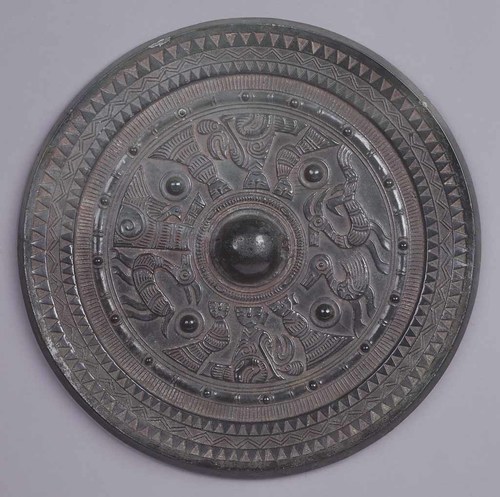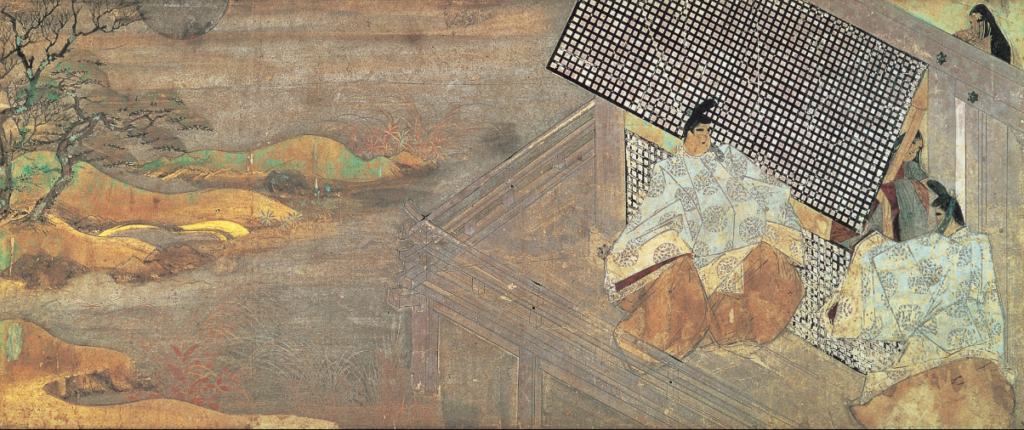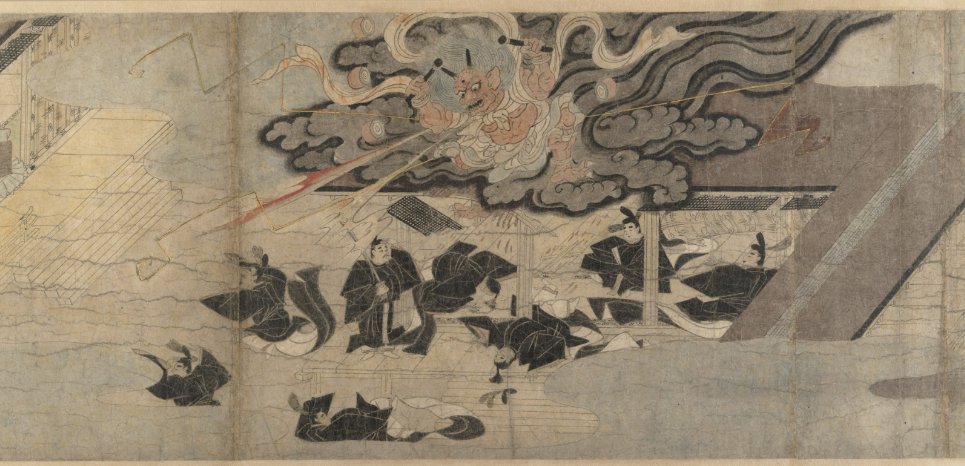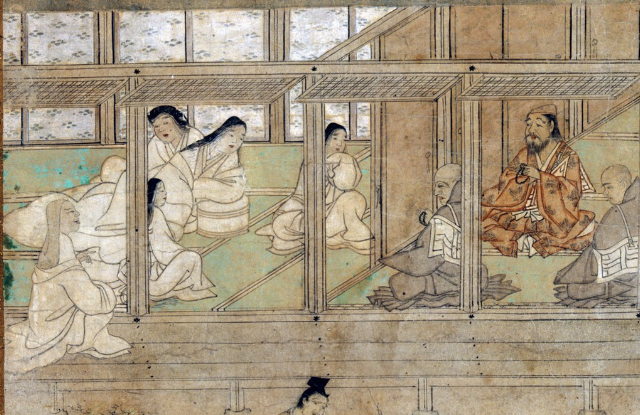The Heian and Kamakura Periods of Japanese history, lasting from 794 CE to 1186 CE (the Heian Period) and from 1186 CE to 1333 CE (the Kamakura Period), gave birth to two distinct styles of Japanese painting: Onna-e, meaning feminine painting, and Otoko-e, meaning masculine painting. Onna-e is a feminine painting style that portrays the feminine side of Japanese culture in the Kamakura period and is characterized by rich colors, depictions of courtly and private households, women, flowers, and other things viewed as inherently feminine in the 8th to the 14th centuries. Otoko-e, on the other hand, is a masculine painting style that portrays the masculine side of society through strong calligraphic brushstrokes, heavily detailed male faces, scenes of war and conflict, depictions of gods, and scenes of public life. These painting styles coincide perfectly with the view of gender roles in Japanese society in the Heian and Kamakura periods, where there was a stark divide between male and female opportunities.
The Start of the Gender Divide: The Introduction of Buddhism
To understand why the gender roles of men and women took such a drastic turn at the start of the Heian Period, we must first look at the societal effects that the Shinto religion had as opposed to Buddhism. Shinto was the main religion of early Japan all the way to the 6th century CE, before Buddhism took its place. The reason that women had more rights and power in early Japan was that the Shinto religion, and therefore society, viewed all women as inherently peaceful and sacred. They were able to become rulers, shamanesses, and chieftains, as well as own land and become samurai.
Queen Himiko is a good example of a powerful ruler and shamaness in early Japan under the Shinto religion. She ruled for sixty-seven years, from 180 CE to 247 CE, during the Yayoi Period. Himiko was said to be a descendant of the Shinto Sun Goddess Amaterasu, and her name, translated into English as “Sun Daughter,” alludes to this relationship. She came into power after a long period of violence and war under the rule of men. She was known by the Contemporary Chinese State as the ruler of all the Japanese Islands, numbering over thirty, which was noted in the Chinese history book Wei Chih (‘History of the Kingdom of Wei’). This book is where all the information on Queen Himiko came from, as it is quite probable that she was banished from all historical records by later Japanese male writers in the 8th century CE (the beginning of Buddhism and fall of Shintoism) who “were keen to establish a male-only line of sovereigns on the Japanese throne” (Cartwright 2017). Nihon Shoki (720 AD) and Kojiki (712 AD) were the first Japanese history books, and there is no mention of her in either one, almost as if she was erased.

When Buddhism overtook Shinto’s place as Japan’s national religion in 552 CE, its beliefs started pervading Japanese society. One of the most impacted groups during this time was women. Japanese women’s status began to decline rapidly, as one of the main beliefs intrinsic to Buddhism was that women were inherently evil. They were slowly and deliberately shut off from places of leadership, worship, and even just the world outside of their homes. Remnants of the exclusion of women from leadership and worship still exist in Japan today, such as Mount Omine in Nara Prefecture, a UNESCO world heritage site where women are still not allowed to even enter, let alone hike to the top. Early Buddhists believed that the “impure” and “evil” nature of women would tarnish their sacred spaces of worship. On the homefront, women were—more commonly if they were noblewomen who did not need to work for their families—shut inside their homes to live an isolated, purely domestic life. Women could not talk to men, save for their fathers, brothers, sons, and husbands, unless they were behind a screen or some other sort of barrier. They were reduced to being pawns for their families to marry into wealthier families for the purpose of bringing in more money, which was a tradition in Japanese society that was also carried over from before Buddhism’s existence in Japan. Married women and other women of courtly families were not even allowed to talk to other women outside their families and spent their days isolated in their homes, caring for their children, while their husbands could roam free and have affairs under societal laws. Education, though never really an option for women even before Buddhism, was barred from women, and women who were educated were looked down upon by men for being too ambitious.
Mirroring Society
So, how do these stories of Japanese social history relate to the concepts of Onna-e and Otoko-e paintings? As Japanese society’s gender roles conformed to strict rules under Buddhism, so did Heian and Kamakura period art. I have chosen to study Yamato-e, meaning Japanese paintings, because I believe they are the best example of Japanese society portrayed through its art.
Onna-e Examples

Before introducing the main tenants of the Onna-e style, I believe that it is integral to introduce a woman for whom Japanese culture and writing are both in much debt. Even in the repressive times of the Heian period, there were ways that women strongly impacted the culture from behind the scenes. Murasaki Shibiku, or Lady Murasaki, accomplished this by publishing one of the first novels ever written, which was titled The Tale of Genji. It was published in 1008 CE, after Murasaki’s half-year mourning of her husband, whom she had lost just two years into their marriage. Women were not allowed to get an education during the late Heian Period in which she lived, so Murasaki had to hide her education, which would eventually come out as the novel gained popularity and as she was chosen to be one of Empress Shouji’s helpers. Murasaki learned the art of writing by eavesdropping on her brother’s lessons, from which she got such a grasp of writing that her father was quoted as wishing that she was born a man instead of a woman. Through The Tale of Genji and later her own diary, she introduced to the world the use of hiragana symbols as text, which is widely used today in Japan.
This emaki, which is pictured above in Figure 2 by Fujiwara Nobuzane, shows a scene from the life of Murasaki Shikibu. Because Murasaki was a woman and her novel was about the courtly and intimate lives of men and women, Fujiwara chose to portray the scene in the form of an Onna-e, a feminine painting. The markers of Onna-e in this page from the Murasaki Shikibu Diary Emaki are the vibrant colors of the men’s and women’s robes and the natural landscape outside, the smooth, rounded facial features of both the men and women, and the subject matter itself, which is a visit by men who look to be suitors to a domestic household.

I included this Onna-e handscroll painting because it showcases all the aspects of the Murasaki Shikibu Diary Emaki and another aspect that is integral to the Onna-e style. This aspect is called the “blown-off roof” style, or 不抜き屋台; funuki yatai. It is commonly used in Onna-e styles because of the opportunity to show intimate household happenings by “lifting off the roof.” The other aspects of Onna-e are the rich colors of the robes, flowers, and windows; the rounded, simple facial features; and the depiction of women inside the traditional Japanese household.
The Tale of Warrior Obusuma Saburo was written between the late Heian and early Kamakura Periods and tells the story of two warrior brothers, Yoshimi Jiro and Obusuma Saburo. Yoshimi Jiro is killed by bandits on his way back to Kyoto, and before he dies, he asks Saburo to take care of his wife and children. The scene that this emaki shows seems to be a mourning scene, with Jiro’s wife and children huddled together, lamenting him. This story represents the power men have in society over women because Saburo abuses Jiro’s wife and children and controls their lives, even to the point of replacing Jiro’s daughter with his own in order to marry a provincial governor who fell in love with Jiro’s daughter.
Otoko-e Examples

This Japanese painting in the Otoko-e style pictures Sugawara no Michizane, one of the three vengeful spirits of Japan. This depiction is right after his death, when lightning struck the palace and caused a disaster that killed many of the people who banished him, which was thought to have been brought on by Sugawara no Michizane himself as the Tenjin. He was later enshrined in the Shinto shrines in an attempt to pacify his vengeful spirit. This was not nearly enough, though, and plague and drought spread throughout the country as the sons of the emperor died one by one. Attributing this to Sugawara’s wrath, the imperial court successfully attempted to pacify him by posthumously restoring his title and office. Today, the Tenjin Sugawara has evolved into a benevolent kami (Shinto God) of scholarship.
The action and brutality of this painting make it clear that it is painted in the Otoko-e style. This emaki displays almost all of the tenants of Otoko-e: action, historical events, wars, and sharp facial features, unlike the smooth Onna-e ones. No women are pictured in this important historical piece. They were barred from even being mentioned in historical events in the Kamakura Period unless they directly had to do with the women’s lives. And often in the Kamakura period, women went unseen in the making of history while at the same time being at the forefront of it.

This Yamato-e (Japanese painting) is in the style of Otoko-e, as it shows a battle scene that is part of a bigger war. This scene is important in the history of Japan, as the night attack on the Sanjo Palace was a triumphant event in the larger Heiji Rebellion. No women are shown in this painting, as they were barred from all military and leadership positions by this time. There are also depictions of animals, like horses for example, shown as a part of the battle, which is also characteristic of otoko-e paintings. The narrative of this emaki, as well as other emaki picturing war like itself, is that in Japanese society of the Kamakura period, there was no room or tolerance for women in battle or war. They were to stay home with the children while the men risked their lives and often died according to their societal laws. This scroll is a material example of the divide between genders.
A Fusion of Styles

Hōnen’s birth is pictured in this emaki. He was born in 1113 and was a religious reformer and founder of the first independent branch of Japanese Pure Land Buddhism called Jōdo-shū. This specific scene is just one of 460 sections in the 48 handscrolls of the Illustrated Life and Acts of Hônen, chronicling Hōnen’s life from birth to death and beyond.
It is hard to tell whether this Yamato-e is in the Onna-e or Otoko-e style because it seems to be a mix of both styles. Men have sharp features, and the subject matter is historical. Women have smooth features, and the scene is shown in the intimate quarters of a homestead, with an open floor plan showing the inner rooms. I believe the artist was instinctively guided by the societal roles of men and women to draw distinctly two different styles in this painting; this resulted in a fusion of both Onna-e and Otoko-e styles, whether the artist painted intentionally or not.
“Japan-ness” Through Centuries
The term “Japan-ness” is open-ended in many ways. What exactly is it if everyone has such different views and observations on it? In my opinion, the influences of Japanese artists, writers, warriors, shoguns, and all other important figures in history define what Japan-ness really is. And it is often the people who go unseen who can make the most impact on their culture’s society. I believe a good way to show my definition of Japan-ness is to illuminate the work of Murasaki Shikibu. With just one text and one diary, she changed the tide of Japan’s written language and inspired women all over the country to fight for their education. She showed them that it was worth it to learn, to read, to write. I believe that this is the essence of Japan-ness. The impact of society on the self and the impact of the self on society go hand in hand, though the latter is not often visible to the eye. Japan’s unique history, reflected in art throughout all periods but especially in the emaki of the Kamakura Period, is what makes up the essence of Japan-ness. It is always there, never wavering, powerful, and unseen.
Bibliography
Abe, Ryūichi. The Weaving of Mantra: Kūkai and the Construction of Esoteric Buddhist Discourse. New York City: Columbia University Press, 1999.
Abiko, B. Kamakura period. Grove Art Online. Retrieved 7 Mar. 2023, from https://www.oxfordartonline.com/groveart/view/10.1093/gao/9781884446054.001.0001/oao-9781884446054-e-7000045586.
Allen, Jay. “Murasaki Shikibu: The First Lady of Japanese Literature.” Unseen Japan, 29 Sept. 2022, https://unseenjapan.com/whos-who-murasaki-shikibu/.
Bopp, Susan. “Theme: Language and Gender Perception in the Art of Japan’s Heian Period.” Japanese Landscapes, JapaneseLandscapes.wordpress, 18 Dec. 2009, https://japaneselandscape.wordpress.com/literature/theme-language-and-gender-perception-in-the-art-of-japans-heian-period/.
Budick, Ariella. “The Tale of Genji – a Radiant Collection of Art Inspired by the World’s First Novel.” Financial Times, April 18, 2019. https://www.ft.com/content/91b5eb3c-5b86-11e9-840c-530737425559.
Kidder, J. Edward Jr. The Art Of Japan. New York City: Park Lane Publishers, 1985.
Kincaid, Chris. “Heian Period Sexual Politics, Marriage, and Sex.” Japan Powered, July 5, 2020. https://www.japanpowered.com/history/sexual-politics-heian-period.
Silva, Mallary A. “Women in Ancient Japan: From Matriarchal Antiquity to Acquiescent Confinement.” Inquiries Journal, Inquiries Journal, 1 Sept. 2010, http://www.inquiriesjournal.com/articles/286/women-in-ancient-japan-from-matriarchal-antiquity-to-acquiescent-confinement.
“Women in Early Japan.” StudySmarter US. Accessed May 9, 2023. https://www.studysmarter.us/explanations/history/modern-world-history/women-in-early-japan/.
“Women in Shinto.” Encyclopedia, October 17, 2022. https://encyclopedia.pub/entry/29555#:~:text=Women%20in%20Shinto%20have%20long,the%20will%20of%20the%20spirit.
Yiengpruksawan, M., & Parker, J. Kamakura. Grove Art Online. Retrieved 7 Mar. 2023, from https://www.oxfordartonline.com/groveart/view/10.1093/gao/9781884446054.001.0001/oao-9781884446054-e-7000045575.